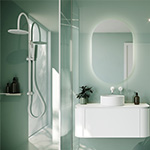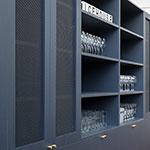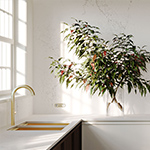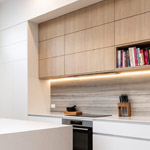In light of recent media coverage of engineered stone (which has highlighted the risk of silicosis if stone is not processed and fabricated using best practice guidelines) we wanted to take a moment to address any concerns you may have. We include an official Caesarstone® response to claims made in recent news coverage which you can read here.
The health and safety of our team, customers, and our community is our highest priority, which is why we have assessed the safety practices of every new fabricator customer since we commenced distributing Caesarstone, to ensure they understand the risks and can meet or exceed safety standards.
Laminex New Zealand is also a founding member of the New Zealand Engineered Stone Advisory Group (NZESAG), an industry group created to ensure our customers and the wider industry are educated & trained on best practice fabrication. We encourage all fabricators and installers to gain accreditation through the Engineered Stone Advisory Group (NZESAG) and follow the guidelines developed with provider IMPAC. Both the accreditation programme and the guidelines have been peer reviewed by ACC and WorkSafe.
The Australian government is considering banning standard or high silica content engineered stone, moving to low silica (less than 40%) content engineered stone only. We understand the New Zealand government is also considering similar changes. We support this, and we are working to source our entire range of engineered stone in a low silica format. However, it’s important to note the same safety requirements to cut, process and fabricate products with any silica content, like engineered stone, porcelain and natural stone remain the same. We've created the Q&A below to help further your understanding about the safety of fabricated engineered stone.
Can silica dust be managed? There are a number of safety measures that can be put in place to reduce the exposure to silica dust, these include air monitoring, education and training, use of appropriate PPE and dust control measures such as water suppression (more detail in the NZESAG Good Practice Guide).
How prevalent is silicosis? To date, cases of silicosis are rare in New Zealand. However, there are a number of cases (70+) of engineered stone fabrication workers in Australia who have contracted the respiratory disease from exposure to RCS.
Are fabricated engineered stone products unsafe? Engineered stone is safe, it is only during processing and fabrication that silica dust can be produced, and this can be managed and minimised by using controls including using water suppression and recommended housekeeping practices. The finished and installed product such as a kitchen benchtop is entirely safe.
Will engineered stone be banned in Australia and NZ? The Australian Govt is considering moving to licensing stone fabricators, regulating industry, and banning standard/high silica content engineered stone, moving to low silica (less than 40%) content engineered stone only. We support this proposed change. This would ensure the content falls within a broad range that natural stone, ceramic, brick and concrete products can contain. The Australian Government has indicated its decision will be made by September, with changes likely by July 2024. Worksafe and the NZ Government are also considering changes that could be made in NZ.
Will Caesarstone continue to supply engineered stone with standard silica content to the NZ market? Our supplier, Caesarstone, has undertaken to progressively update our entire engineered stone range to low silica content in 2024 regardless of regulatory changes. It’s important to note the requirements and controls to cut, process and fabricate engineered stone remain the same, regardless of silica content.
Can silica dust be managed? There are a number of safety measures that can be put in place to reduce the exposure to silica dust, these include air monitoring, education and training, use of appropriate PPE and dust control measures such as water suppression (more detail in the NZESAG Good Practice Guide).
How prevalent is silicosis? To date, cases of silicosis are rare in New Zealand. However, there are a number of cases (70+) of engineered stone fabrication workers in Australia who have contracted the respiratory disease from exposure to RCS.
Are fabricated engineered stone products unsafe? Engineered stone is safe, it is only during processing and fabrication that silica dust can be produced, and this can be managed and minimised by using controls including using water suppression and recommended housekeeping practices. The finished and installed product such as a kitchen benchtop is entirely safe.
Will engineered stone be banned in Australia and NZ? The Australian Govt is considering moving to licensing stone fabricators, regulating industry, and banning standard/high silica content engineered stone, moving to low silica (less than 40%) content engineered stone only. We support this proposed change. This would ensure the content falls within a broad range that natural stone, ceramic, brick and concrete products can contain. The Australian Government has indicated its decision will be made by September, with changes likely by July 2024. Worksafe and the NZ Government are also considering changes that could be made in NZ.
Will Caesarstone continue to supply engineered stone with standard silica content to the NZ market? Our supplier, Caesarstone, has undertaken to progressively update our entire engineered stone range to low silica content in 2024 regardless of regulatory changes. It’s important to note the requirements and controls to cut, process and fabricate engineered stone remain the same, regardless of silica content.
Useful links
Caesarstone Silicosis Statement Feb 2023
Caesarstone Health & Safety - Caesarstone New Zealand
NZESAG Respirable Crystalline Silica Accreditation (impac.co.nz)
Laminex New Zealand and Caesarstone’s efforts to improve industry safety are ongoing and we are deeply engaged in the push to improve industry safety. If you have any questions please don’t hesitate to reach out.
Kind Regards,
Mike Arthur
General Manager
Laminex New Zealand






